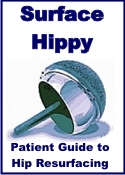|
|
Lessons from the Past: Why Knees Fail
Link
http://www.orthosupersite.com/view.asp?rID=23604
By Paul A. Lotke , MD
ORTHOPEDICS 2007; 30:788
September 2007
Total knee arthroplasty (TKA) has become one of the most successful and
gratifying orthopedic procedures. It has come a long way since Frank Gunston
designed his polycentric knee in Canada in the late 1960s. We have learned a
great deal since the mid 1970s when one of the first metal-polyethylene
bicompartmental knees came onto the market. This knee consisted of two metal
femoral condyles connected with a metal bridge, without a patellar phalange. The
tibial component was highly conforming to the metal condylar surface and both
tibial plateaus were connected with a thin polyethylene bridge. This knee had
some short-term success, but eventually the stress risers under the polyethylene
fixation pegs, the lack of a patellar phalange, the high conformity and weakness
of the polyethylene connecting bridge, and other problems led to its failure. In
addition, the instruments used to insert the knee were rather primitive and
consisted of a single instrumentation guide. From this experience, we learned
that constraint was not good, stress risers were real, and instruments were
essential to success.
Unicompartmental arthroplasties were introduced as metal disks in the 1960s. A
variety of these metal implants existed, including those designed by MacIntosh
and McKeever. They were highly polished metal hemi-disks with or without a
central tibial fixation, and were designed to be used without cement. Ligament
tension was controlled with different thicknesses, but size and ligament tension
were difficult to control . As a result, many of them failed because of poor
ligament tone, loss of component position, and loss of stability in the opposite
compartments. Instruments were essentially nonexistent for this prosthesis. We
learned that resurfacing both sides of a joint was better, and that soft tissue
balancing was critical.
In the late 1970s and early 1980s, hinges came in with great fanfare. A variety
of hinges existed, including the designs of Waldius, Guepar, and others used in
Europe. They were a true single-axis hinge. They allowed for no rotation in the
longitudinal axis or abduction. They were used with or without cement. When they
failed, they led to huge bone defects. We learned that most of them failed,
constraint was not good, and success was fleeting.
Materials became more prominent in our designs in the 1980s. We learned that
metal-on-metal bearings would wear and shed metal particles into the synovium .
We also learned that polyethylene wears and would lead to particulate disease
with osteolysis, and that bone defects were becoming larger and more difficult
to manage.
The total condylar knee was probably the forerunner of the current total knee
design. It was one of the most successful condylar-style designs that were
introduced and became popular in the 1980s. It was revolutionary in its
survivorship and function. Motion was modest, with average flexion of 100, but
survivorship and patient satisfaction was excellent. Some of the problems with
this early total condylar knee were the failures that occurred related to thin
polyethylene without metal support and the subsequent increased pressure in the
subchondral bone. Surprisingly, there was only modest wear in this minimally
conforming knee replacement. This prosthesis set the stage for the generations
of knee replacements that followed.
Revision surgery became an increasing problem in the 1980s. Not only were huge
bone defects present, but some prostheses were difficult to remove. Some of the
most difficult revisions were cemented porous-coated stems. We learned rapidly
that we should not implant anything that does not come out readily.
Through the late 1980s and 1990s, interest in new materials increased. Improved
polyethylenes, metal surface finishes, and metal alloys came to be, as well as
some design changes. Some of these new ideas remained in practice and others
began to fail quickly. We learned that newer is not always better.
More recently, the soft tissue sleeve has gained increasing recognition because
of its importance in the success of TKA. Ligament balance and femoral component
rotation for patellar tracking were appreciated. We learned that the soft
tissues and ligaments are important, that polyethylene could not fully
compensate for a deformity or loss of ligaments, and that good ligament balance
is essential for success.
Today we stand tall on the lessons we have learned from the past. These include
the disadvantages of too much constraint, the reality of stress risers, and the
reality that polyethylene deforms and cannot take structural deforming force. We
saw that instruments are important for proper positioning and that materials are
important, but that newer is not always better. We learned that reasonable
judgment and experience are required to achieve the success that our patients
are currently enjoying from this procedure.
Author
Dr Lotke is from the Department of Orthopedic Surgery,
University of Pennsylvania Llanerch Medical Center, Havertown, Pa.
Correspondence should be addressed to: Paul A. Lotke, MD, University of
Pennsylvania, Llanerch Medical Center, 510 Darby Rd, Havertown, PA 19083.
|
|


